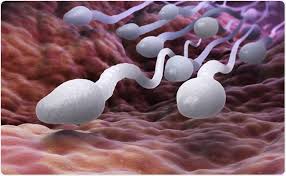 Sperm is a reproductive cell, also known as a gamete, that is produced in the male reproductive system.
Sperm is a reproductive cell, also known as a gamete, that is produced in the male reproductive system.
The structure of sperm can be broken down into three basic parts:
1. Head: The head of the sperm contains the genetic material (DNA) that is required to fertilize an egg. It is capped with a specialized structure called an acrosome, which helps the sperm penetrate the egg.
2. Midpiece: The midpiece contains a large number of mitochondria, which provide the energy needed for the sperm to move.
3. Tail: The tail, also known as the flagellum, is a long, whip-like structure that propels the sperm forward.
Sperm anatomy can vary slightly depending on the species, but the basic structure described above is consistent across most animals.
Sperm cells form during the process known as spermatogenesis, which takes place in the seminiferous tubules of the testes.
There are several successive sperm cell precursors, starting with spermatogonia, which differentiate into spermatocytes.
The spermatocytes then undergo meiosis, reducing their chromosome number by half, which produces spermatids.
The spermatids then mature, construct a tail, or flagellum, which gives rise to the mature, motile sperm cell.
This whole process occurs constantly and takes around 3 months from start to finish.
The initial spermatozoon process takes around 70 days to complete.
Sperm cells cannot divide and have a limited lifespan.
After fusion with egg cells during fertilization, a new organism begins developing, starting as a totipotent zygote.
The human sperm cell is haploid, so that its 23 chromosomes can join the 23 chromosomes of the female egg to form a diploid cell with 46 paired chromosomes.
Sperm is stored in the epididymis and is released from the penis during ejaculation in a fluid known as semen.
The main sperm function is to reach the ovum and fuse with it to deliver two sub-cellular structures: (i) the male pronucleus that contains the genetic material and (ii) the centrioles that are structures that help organize the microtubule cytoskeleton.
Sperm cell can be divided in 2 parts:
Head: contains the nucleus with densely coiled chromatin fibers, surrounded anteriorly by a thin, flattened sac called the acrosome.
The acrosome contains enzymes used for penetrating the female egg.
The head also contains vacuoles.
Tail: also called the flagellum, is the longest part and capable of wave-like motion that propels sperm for swimming and aids in the penetration of the egg.
The midpiece has a central filamentous core with many mitochondria spiralled around it, used for ATP production for the journey through the female cervix, uterus, and uterine tubes.
During fertilization, the sperm provides three essential parts to the oocyte: (1) a signalling or activating factor, which causes the metabolically dormant oocyte to activate; (2) the haploid paternal genome; (3) the centriole, which is responsible for forming the centrosome and microtubule system.
Sperm cells are carried out of the male body in a fluid known as semen.
Human sperm cells can survive within the female reproductive tract for more than 5 days post coitus.
Semen is produced in the seminal vesicles, prostate gland and urethral glands.
Sperm quantity and quality are the main parameters in semen quality, which is a measure of the ability of semen to accomplish fertilization.
Sperm quantity and quality are a measure of fertility in a man.
The genetic quality of sperm, as well as its volume and motility, all typically decrease with age.
DNA damages present in sperm cells in the period after meiosis but before fertilization may be repaired in the fertilized egg, but if not repaired, can have serious deleterious effects on fertility and the developing embryo.
